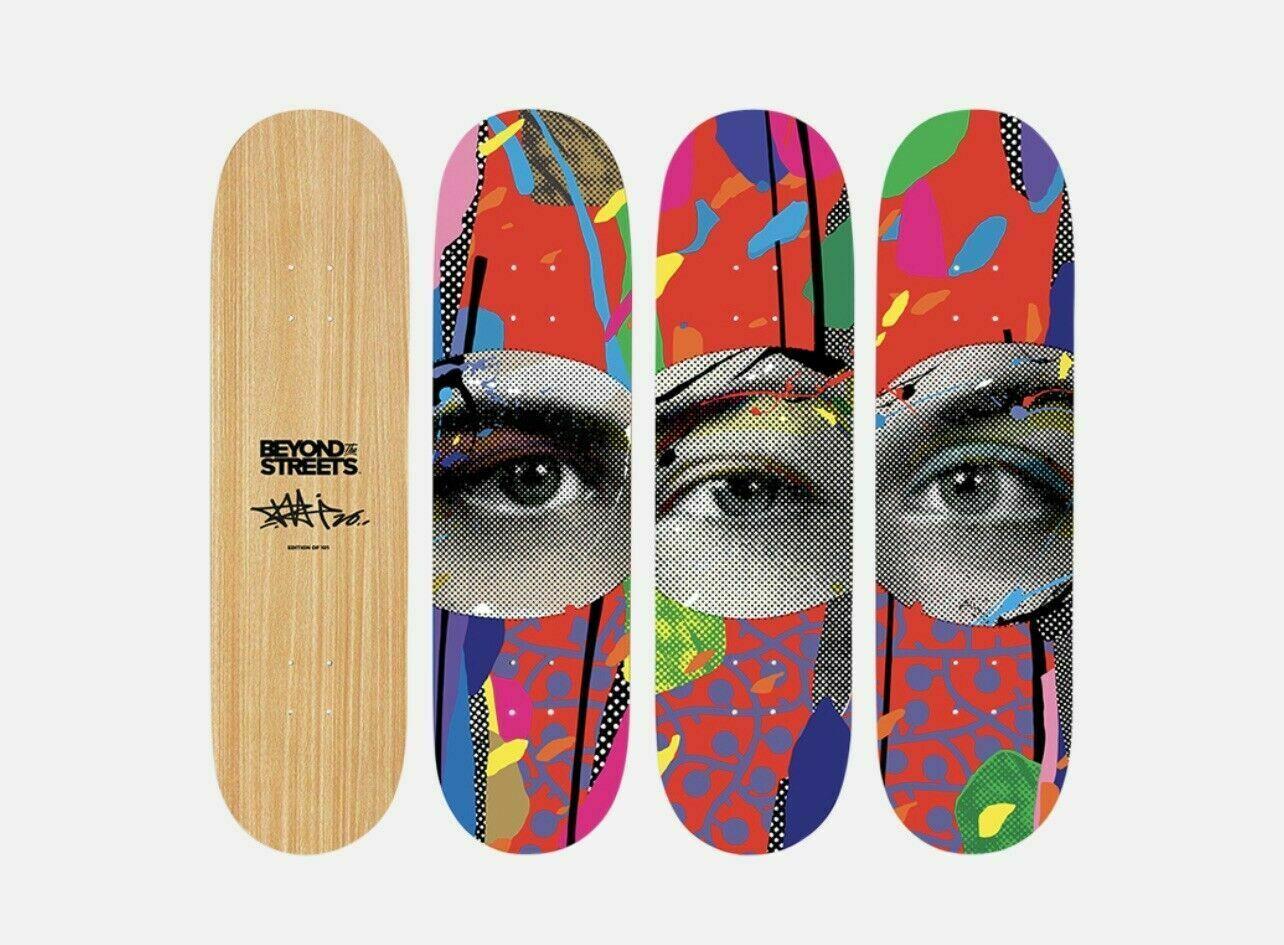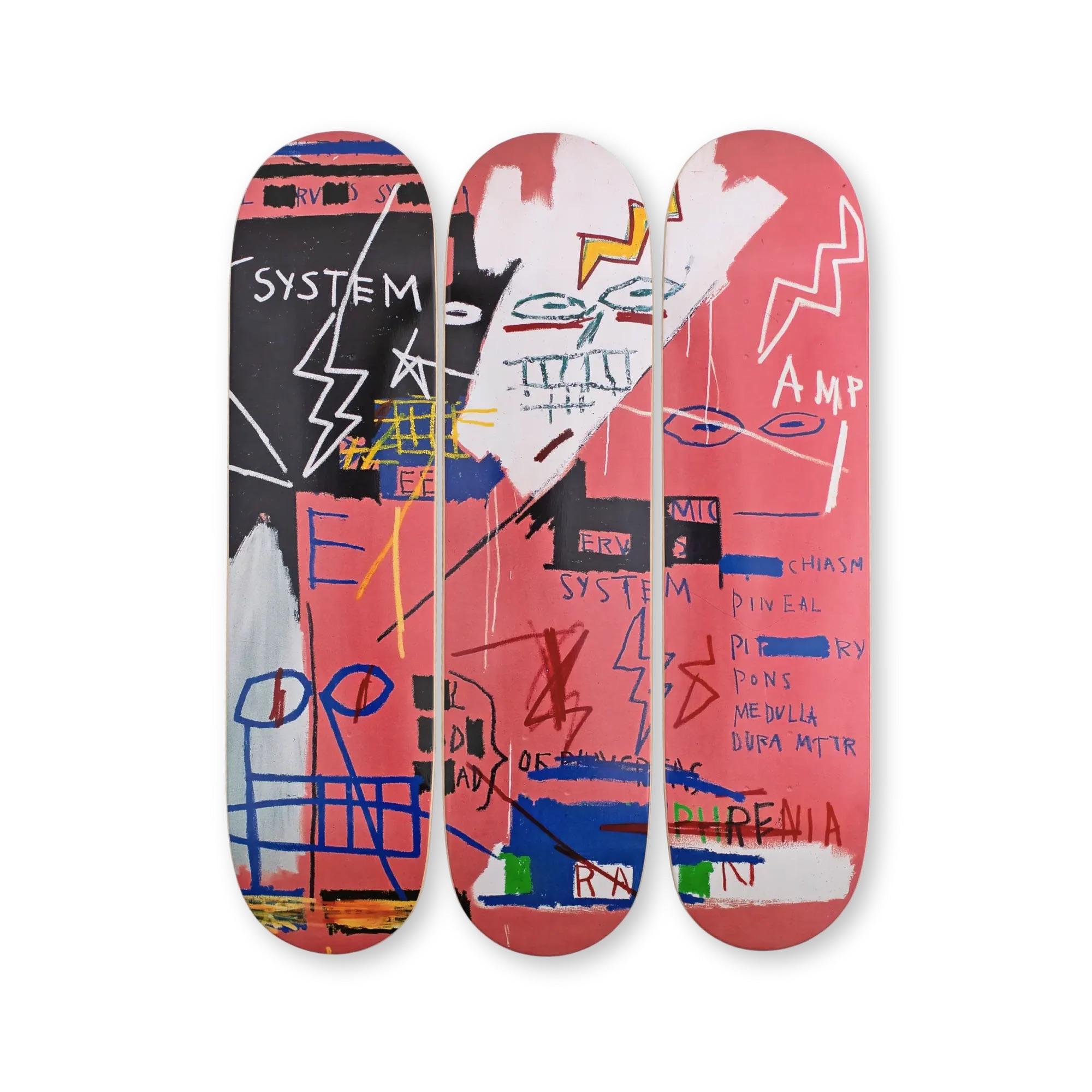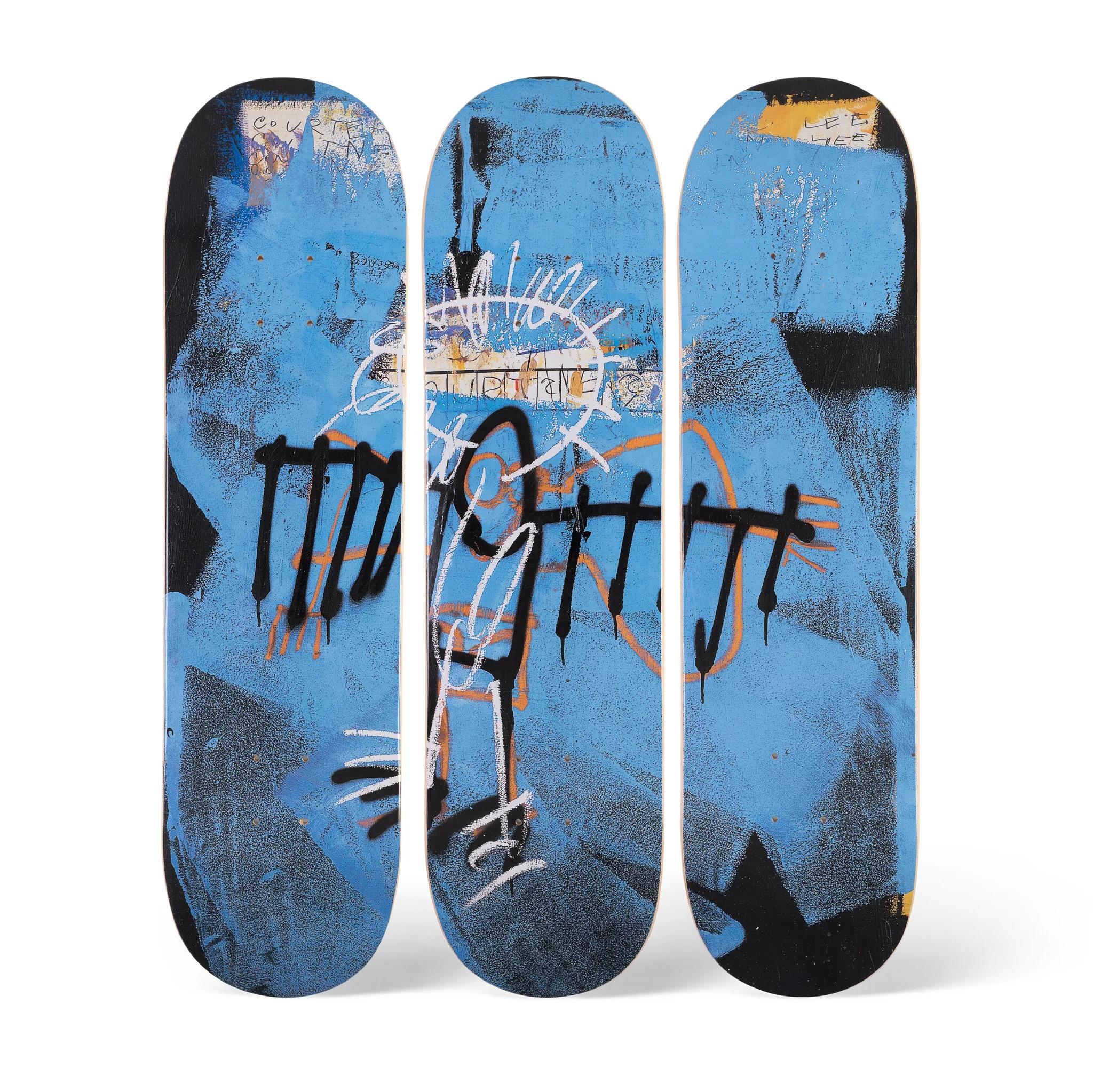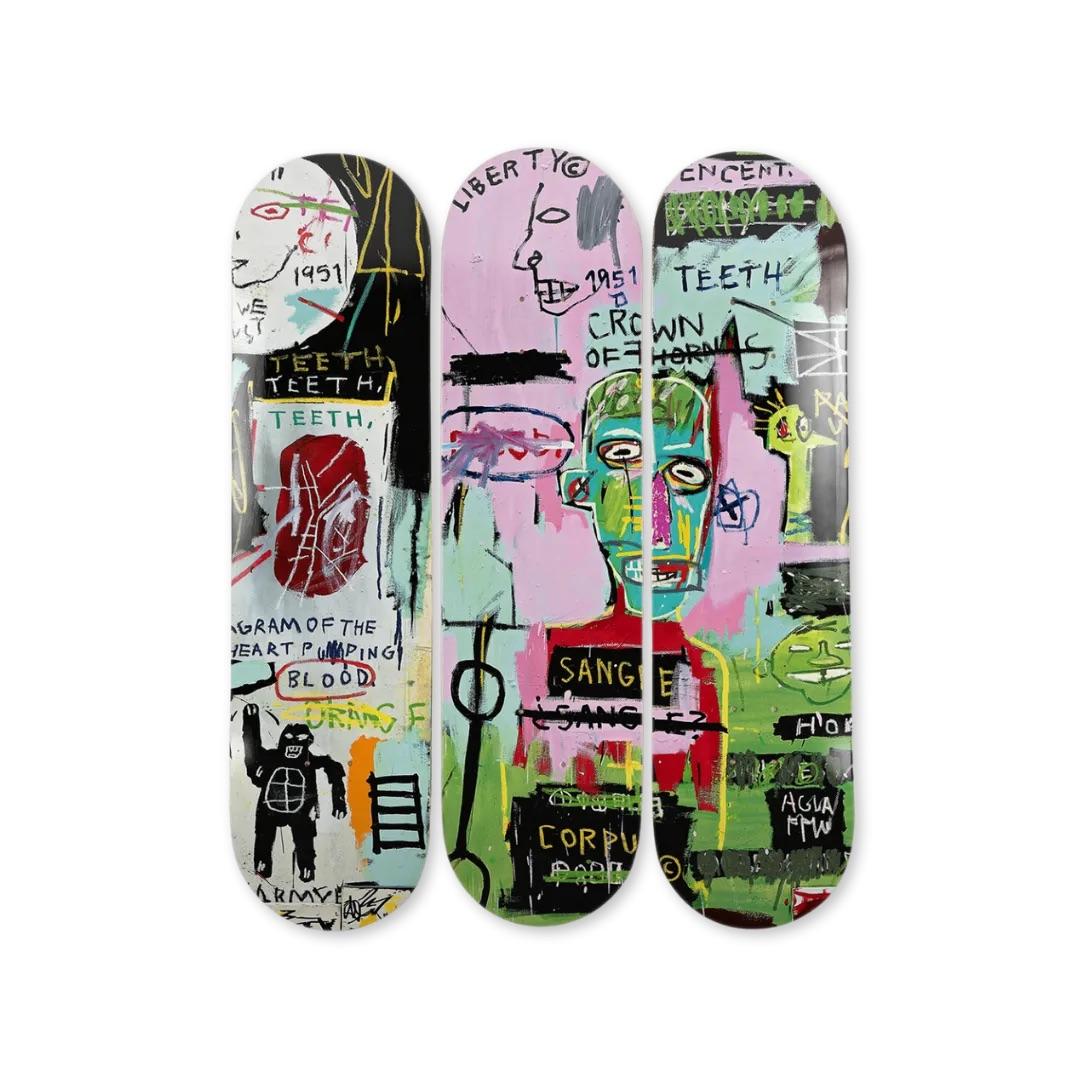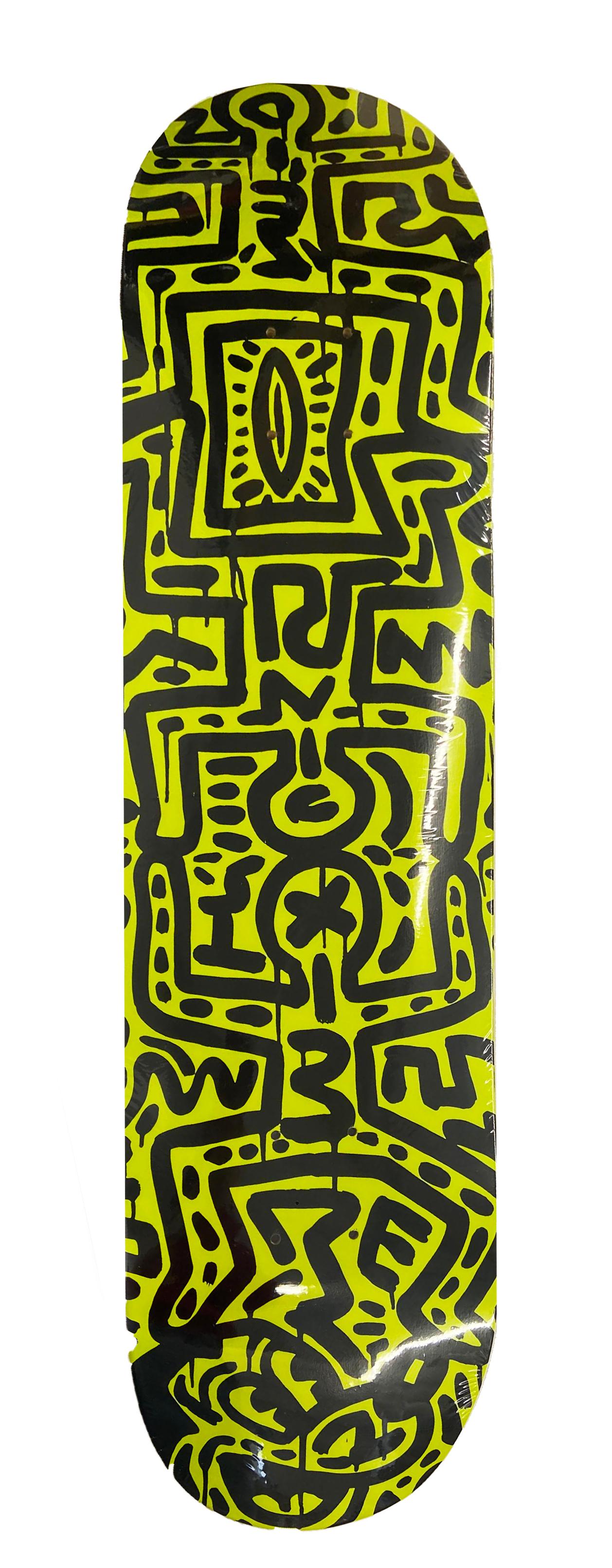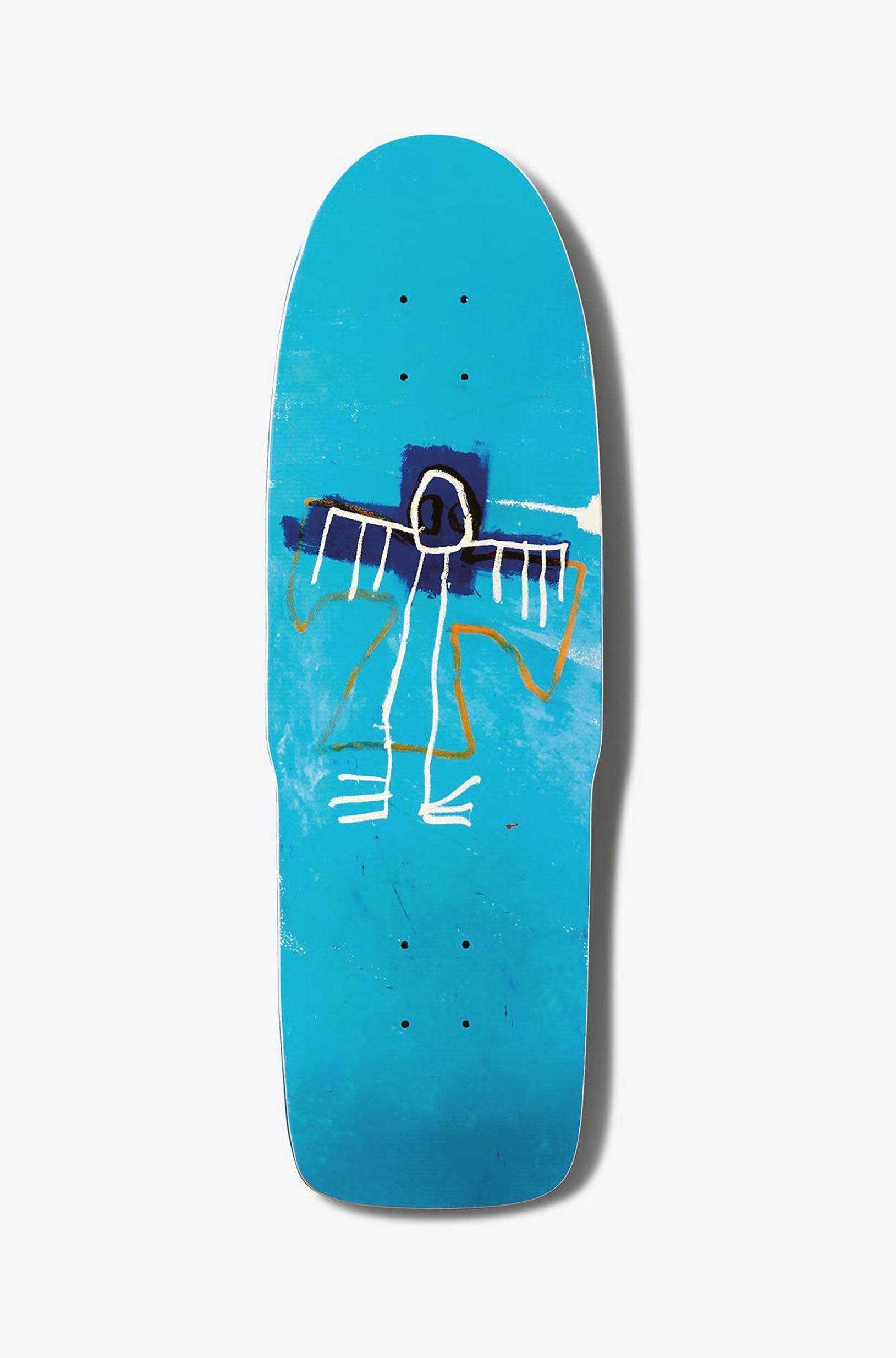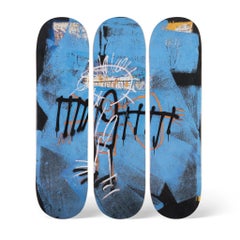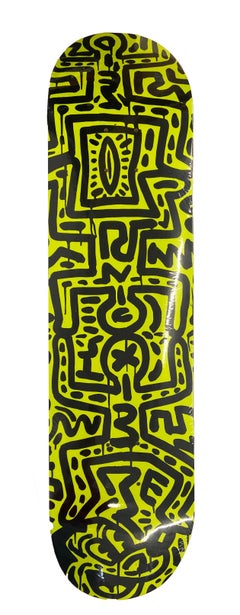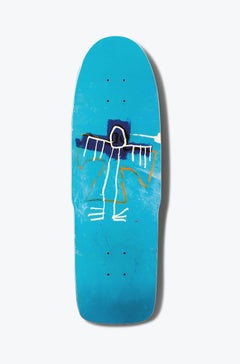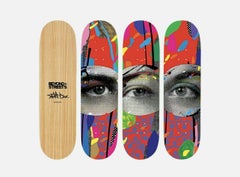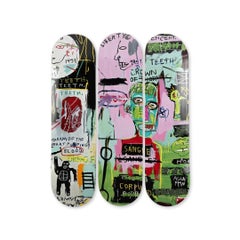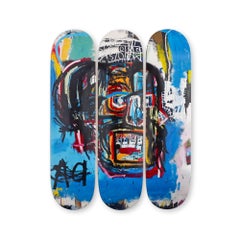Items Similar to Futura Skateboard Deck (Futura 2000)
Want more images or videos?
Request additional images or videos from the seller
1 of 5
FuturaFutura Skateboard Deck (Futura 2000)2023
2023
$325
£248.63
€285.95
CA$464.14
A$511.61
CHF 264.35
MX$6,115.94
NOK 3,325.54
SEK 3,125.53
DKK 2,135.80
About the Item
Futura Skateboard Deck:
Medium: Silkscreen on Maplewood Skateboard Deck. Year: 2023.
Dimensions: 31 x 8 inches (38.1 x 22.9 cm).
In original shrink wrap; excellent condition.
Printed signature from an edition of unknown.
Published by Futura Laboratories.
Futura 2000:
The living legend of the graffiti movement, illustrator, photographer, sculptor, fashion and graphic designer from New York City, Futura – also known as Futura 2000 – is one of the major players on the current international urban art scene. The contemporary of SAMO, Keith Haring, Richard Hambleton, Rammellzee and many other iconic NY writers, Futura helped define the graffiti movement of the early 1970s by moving it away from lettering and towards the more painterly, abstract style. This highly influential and multi-faceted artist has, to date, remained unique, fresh, and evolving, and his characteristic style has paved the way for a whole new generation of high-profile urban artists.
Related Categories
Street Art. KAWS. Art toy. Figurines. East Village Art. Graffiti and Street Art. Subway Art. Takashi Murakami. Futura 2000.
- Creator:
- Creation Year:2023
- Dimensions:Height: 31 in (78.74 cm)Width: 8 in (20.32 cm)
- Medium:
- Movement & Style:
- Period:
- Condition:
- Gallery Location:NEW YORK, NY
- Reference Number:1stDibs: LU354317074982
About the Seller
5.0
Vetted Professional Seller
Every seller passes strict standards for authenticity and reliability
Established in 2014
1stDibs seller since 2016
4,581 sales on 1stDibs
Typical response time: <1 hour
- ShippingRetrieving quote...Shipping from: New York, NY
- Return Policy
Authenticity Guarantee
In the unlikely event there’s an issue with an item’s authenticity, contact us within 1 year for a full refund. DetailsMoney-Back Guarantee
If your item is not as described, is damaged in transit, or does not arrive, contact us within 7 days for a full refund. Details24-Hour Cancellation
You have a 24-hour grace period in which to reconsider your purchase, with no questions asked.Vetted Professional Sellers
Our world-class sellers must adhere to strict standards for service and quality, maintaining the integrity of our listings.Price-Match Guarantee
If you find that a seller listed the same item for a lower price elsewhere, we’ll match it.Trusted Global Delivery
Our best-in-class carrier network provides specialized shipping options worldwide, including custom delivery.More From This Seller
View AllJean-Michel Basquiat skateboard decks 2020 (Basquiat Angel)
By Jean-Michel Basquiat
Located in NEW YORK, NY
Jean-Michel Basquiat skateboard deck set:
Basquiat skateboard decks licensed by the Estate of Jean Michel Basquiat in conjunction with Artestar circa 2020, featuring offset imagery o...
Category
2010s Pop Art More Art
Materials
Wood, Offset
Keith Haring Skateboard Deck
By (after) Keith Haring
Located in NEW YORK, NY
Keith Haring Mickey Mouse Skateboard Deck:
Standout Keith Haring Skateboard Deck featuring lush, vibrant, fun colors & classic early 1980s Keith Haring Mickey Mouse imagery. A brilliant piece of Haring wall-art that hangs with ease.
This work originated from the sold out collaboration between Diamond Supply and the Keith Haring Foundation. The deck is housed in its original shrink-wrap and bares the copyright of the Haring foundation on the reverse.
Medium: Maple wood skateboard deck. 2021.
Approximate Dimensions: 8.0 x 31 inches (20.5 x 79 cm).
In original shrink wrapping; excellent overall condition.
Estate trademark & Haring printed signature on the reverse. From sold out/out of print edition of unknown.
Keith Haring rose to prominence in 1980s New York within the East Village art scene alongside Jean-Michel Basquiat, Kenny Scharf, and Jenny Holzer. He bridged the gap between the art world and the street, graffiting city subways and sidewalks before committing to a studio practice. Haring united the appeal of cartoons with the raw energy of Art Brut artists such as Jean DuBuffet as he developed a distinct pop-graffiti aesthetic that comprised energetic, boldly outlined figures against solid or patterned backdrops. His major themes included exploitation, subjugation, drug abuse, and the threat of nuclear holocaust; Haring boldly engaged with social issues, especially after receiving an AIDS diagnosis in 1987. Today, his work sells for seven figures at auction and has been the subject of solo shows at the Brooklyn Museum, the San Francisco Museum of Modern Art, and the Albertina Museum in Vienna, among other institutions.
Related Categories
Pop Art. Graffiti. Street art. skate art...
Category
1980s Pop Art Prints and Multiples
Materials
Wood, Offset
Basquiat Skateboard deck 2018 (Basquiat skate deck)
By Jean-Michel Basquiat
Located in NEW YORK, NY
Jean-Michel Basquiat Skateboard Deck:
Limited edition skate deck licensed by the Estate of Jean Michel Basquiat in conjunction with Artestar in 2018, featuring the much iconic early ...
Category
2010s Contemporary Prints and Multiples
Materials
Wood, Screen
Keith Haring Skateboard Deck (Keith Haring Mickey Mouse)
By (after) Keith Haring
Located in NEW YORK, NY
Keith Haring Mickey Mouse Skateboard Deck:
Standout Keith Haring Skateboard Deck featuring lush, vibrant, fun colors & classic early 1980s Keith Haring Mickey Mouse imagery. A brilli...
Category
1980s Pop Art More Art
Materials
Wood, Offset
$380 Sale Price
20% Off
Mark Gonzales Supreme skate deck
By Mark Gonzales
Located in NEW YORK, NY
Mark Gonzales Supreme Skateboard Deck 2017:
Dimensions: 31.5 x 8 x 0.5 in. (80.01 x 20.32 cm).
Medium: Offset print on Maple Wood.
Printed artist sig...
Category
21st Century and Contemporary Street Art Prints and Multiples
Materials
Screen
Andy Warhol Cow Skate Deck 2010
By (after) Andy Warhol
Located in NEW YORK, NY
Vintage Andy Warhol Cow Skateboard Deck:
This work originated circa 2010 as a result of the collaboration between Alien Workshop and the Andy Warhol Foundation. A brilliant piece of...
Category
1960s Pop Art More Art
Materials
Offset, Wood
You May Also Like
Paul Insect I SEE Skateboard Deck Set Of 3 Beyond The Streets Signed XX/101 COA
By Paul Insect
Located in Draper, UT
Paul Insect:
Paul Insect is a UK contemporary artist. Best known for his collective named ‘insect’ that started in 1996 he is a collage, portrait master w...
Category
2010s Pop Art More Prints
Materials
Screen
JEAN-MICHEL BASQUIAT - Six Fifty. Skate Decks Pop Urban Art Design
By Jean-Michel Basquiat
Located in Madrid, Madrid
Jean-Michel Basquiat - Six Fifty
Date of creation: 2024
Medium: Digital print on Canadian maple wood
Edition: Open
Size: 80 x 20 cm (each skate)
Condition: In mint conditions and never displayed
This triptych is formed by three skate decks made of 7 ply grade A Canadian maple wood.
© Estate of Jean-Michel Basquiat. Licensed by Artestar, New York
Six Fifty (1982) powerfully distills the symbolic universe and raw energy that define Jean-Michel Basquiat’s artistic language. In this piece, the artist uses a loaded iconography—lightning bolts, bones, swords, arrows, crowns—that serves as a kind of visual alphabet through which he explores themes of identity, violence, power, and cultural heritage.
With his gestural and spontaneous style, Basquiat turns the canvas into a field of tension between chaos and control, between the urgency of the street and the depth of critical thought. Like much of his work, this piece does not seek a single interpretation but instead opens multiple layers of meaning through graphic elements that seem to arise directly from the urban subconscious.
Six Fifty is not just a visual representation—it is a visceral statement, a fragment of the noise and pulse of 1980s New York, where Basquiat emerged as a radical voice in contemporary art. His ability to combine the immediacy of graffiti with historical, anatomical, and cultural references is fully evident here.
ABOUT THE ARTIST
Jean-Michel Basquiat (1960-1988) was one of the most influential artists of the 20th century, famous for his ability to fuse urban culture, social criticism and art history into a unique style. Born in Brooklyn, New York, to a Haitian father and Puerto Rican mother, his life and work were shaped by his multicultural heritage, the New York art scene and the social tensions of his time. Although his career was brief, his impact on contemporary art has been lasting and significant.
Basquiat showed an interest in art from an early age. His mother, Matilde Andrades, took him to museums and encouraged him to draw. At the age of seven, a car accident left him hospitalized for a time, and it was then that his mother gave him a copy of the anatomy book Gray's Anatomy, which influenced his fascination with the human body and its visual representation.
Despite his early talent, Basquiat's family life was turbulent. His mother was hospitalized for psychiatric problems and his relationship with his father, Gerard Basquiat, was troubled. This instability contributed to Basquiat dropping out of school at age 17 to pursue his artistic career on the streets of New York.
As a teenager, Basquiat joined the New York graffiti scene under the pseudonym SAMO (an acronym for "Same Old Shit"), which he used to sign his cryptic and poetic messages on the streets of Manhattan with his friend Al Diaz. SAMO's graffiti were a mixture of philosophical and social commentary on popular culture, capitalism and religion, and soon attracted the attention of the underground art scene.
In 1980, SAMO "died" when Basquiat and Diaz decided to end their collaboration, marking the beginning of Basquiat's transition from street graffiti to art galleries.
Basquiat emerged as a talent to watch in 1980, when he participated in the group exhibition The Times Square Show, which included other emerging artists from New York's Lower East Side scene. That same year, he attracted the attention of critics and collectors who saw in his work an electrifying blend of street art and neo-expressionism, the predominant movement of the time.
In 1981, art critic René Ricard published the influential essay The Radiant Child in Artforum magazine, which positioned Basquiat as one of the most promising artists of his generation. Shortly thereafter, he met renowned artist Andy Warhol, with whom he formed a close friendship and significant artistic collaboration. This association was instrumental in catapulting his career into the world of high art.
The collaboration with Warhol was a pivotal point in Basquiat's career. The two artists, although coming from very different worlds, shared a fascination with fame and popular culture. Together, they produced a series of works that combined Warhol's pop art icons with Basquiat's raw, spontaneous style.
However, this collaboration was also a source of controversy. Many critics accused Warhol of "exploiting" Basquiat, while others saw the collaboration as a creative dialogue between two genius minds. Although the criticism was mixed, there is no doubt that the relationship between the two artists helped cement Basquiat's reputation in the art world.
Basquiat's style is a unique amalgam of influences. His work is characterized by the use of dismembered human figures, skeletons and internal organs, evoking the fragility of the body and mortality. Basquiat also used symbols that alluded to African-American and African history, such as crowns, masks and references to historical figures such as Toussaint Louverture.
The use of text is another crucial aspect of his work. Words, phrases and numbers appeared in his paintings, often crossed out or overlapped, creating a sense of controlled chaos. These fragmented words provoked a non-linear reading of his works and conveyed multiple layers of meaning.
His art also reflected his concerns about racial issues, especially the place of people of African descent in Western art history and in society at large. The crowns that Basquiat often drew on his figures were a symbol of power and resistance, a way of proclaiming himself "king" in a world that had historically excluded black artists from the upper echelons of art.
In works such as The Death of Michael...
Category
2010s Pop Art More Art
Materials
Wood, Digital
JEAN-MICHEL BASQUIAT - In Italian. Skate Decks Pop Urban Art Design
By Jean-Michel Basquiat
Located in Madrid, Madrid
Jean-Michel Basquiat - In Italian
Date of creation: 2024
Medium: Digital print on Canadian maple wood
Edition: Open
Size: 80 x 20 cm (each skate)
Condition: In mint conditions and never displayed
This triptych is formed by three skate decks made of 7 ply grade A Canadian maple wood.
© Estate of Jean-Michel Basquiat. Licensed by Artestar, New York
In Italian (1983) is one of Jean-Michel Basquiat’s iconic works, created during a peak period of his artistic career. The piece reflects his distinctive style, blending graffiti, expressive brushwork, text, and symbolism. Like many of his paintings, "In Italian" presents a powerful and chaotic composition where words, figures, and signs interact in a raw and energetic visual language.
The title, In Italian, may suggest a reference to classical European culture—especially Italian Renaissance art—while at the same time subverting it through Basquiat’s urban, Afro-Caribbean perspective. His interest in contrasting high and low culture, refined and raw, is evident in this piece. The inclusion of text, often fragmented or cryptic, was one of Basquiat’s trademarks and serves here to provoke thought rather than deliver a clear message.
In this work, Basquiat explores themes such as identity, language, cultural heritage, and the appropriation of symbols. The figure depicted—alongside the textual elements—appears almost mythological or totemic, reinforcing Basquiat’s tendency to elevate marginalized characters into powerful, almost divine figures.
The brushstrokes are urgent, the colors bold, and the composition layered. It’s as if the viewer is meant to decipher a code—a mix of history, race, rebellion, and irony. Words in different languages, especially English and Italian, appear not to clarify meaning but to complicate it, suggesting the multilingual, multicultural environment Basquiat inhabited and commented on.
In Italian is a prime example of how Basquiat merged influences from the streets of New York with art history, African-American identity, and global culture. It's a bold visual statement that challenges traditional canons and forces the viewer to reconsider what art is, who gets to create it, and which voices are heard.
ABOUT THE ARTIST
Jean-Michel Basquiat (1960-1988) was one of the most influential artists of the 20th century, famous for his ability to fuse urban culture, social criticism and art history into a unique style. Born in Brooklyn, New York, to a Haitian father and Puerto Rican mother, his life and work were shaped by his multicultural heritage, the New York art scene and the social tensions of his time. Although his career was brief, his impact on contemporary art has been lasting and significant.
Basquiat showed an interest in art from an early age. His mother, Matilde Andrades, took him to museums and encouraged him to draw. At the age of seven, a car accident left him hospitalized for a time, and it was then that his mother gave him a copy of the anatomy book Gray's Anatomy, which influenced his fascination with the human body and its visual representation.
Despite his early talent, Basquiat's family life was turbulent. His mother was hospitalized for psychiatric problems and his relationship with his father, Gerard Basquiat, was troubled. This instability contributed to Basquiat dropping out of school at age 17 to pursue his artistic career on the streets of New York.
As a teenager, Basquiat joined the New York graffiti scene under the pseudonym SAMO (an acronym for "Same Old Shit"), which he used to sign his cryptic and poetic messages on the streets of Manhattan with his friend Al Diaz. SAMO's graffiti were a mixture of philosophical and social commentary on popular culture, capitalism and religion, and soon attracted the attention of the underground art scene.
In 1980, SAMO "died" when Basquiat and Diaz decided to end their collaboration, marking the beginning of Basquiat's transition from street graffiti to art galleries.
Basquiat emerged as a talent to watch in 1980, when he participated in the group exhibition The Times Square Show, which included other emerging artists from New York's Lower East Side scene. That same year, he attracted the attention of critics and collectors who saw in his work an electrifying blend of street art and neo-expressionism, the predominant movement of the time.
In 1981, art critic René Ricard published the influential essay The Radiant Child in Artforum magazine, which positioned Basquiat as one of the most promising artists of his generation. Shortly thereafter, he met renowned artist Andy Warhol, with whom he formed a close friendship and significant artistic collaboration. This association was instrumental in catapulting his career into the world of high art.
The collaboration with Warhol was a pivotal point in Basquiat's career. The two artists, although coming from very different worlds, shared a fascination with fame and popular culture. Together, they produced a series of works that combined Warhol's pop art icons with Basquiat's raw, spontaneous style.
However, this collaboration was also a source of controversy. Many critics accused Warhol of "exploiting" Basquiat, while others saw the collaboration as a creative dialogue between two genius minds. Although the criticism was mixed, there is no doubt that the relationship between the two artists helped cement Basquiat's reputation in the art world.
Basquiat's style is a unique amalgam of influences. His work is characterized by the use of dismembered human figures, skeletons and internal organs, evoking the fragility of the body and mortality. Basquiat also used symbols that alluded to African-American and African history, such as crowns, masks and references to historical figures such as Toussaint Louverture.
The use of text is another crucial aspect of his work. Words, phrases and numbers appeared in his paintings, often crossed out or overlapped, creating a sense of controlled chaos. These fragmented words provoked a non-linear reading of his works and conveyed multiple layers of meaning.
His art also reflected his concerns about racial issues, especially the place of people of African descent in Western art history and in society at large. The crowns that Basquiat often drew on his figures were a symbol of power and resistance, a way of proclaiming himself "king" in a world that had historically excluded black artists from the upper echelons of art.
In works such as The Death of Michael Stewart...
Category
2010s Pop Art More Art
Materials
Wood, Digital
JEAN-MICHEL BASQUIAT - Untitled Head (Skull) Skate Decks Urban Art Design
By Jean-Michel Basquiat
Located in Madrid, Madrid
Jean-Michel Basquiat - Untitled Head (Skull 2), 1982
Date of creation: 2024
Medium: Digital print on Canadian maple wood
Edition: Open
Size: 80 x 20 cm (each skate)
Condition: In mint conditions and never displayed
This triptych is formed by three skate decks made of 7 ply grade A Canadian maple wood.
© Estate of Jean-Michel Basquiat. Licensed by Artestar, New York
Untitled Head (Skull 2), 1982, is one of Jean-Michel Basquiat’s most iconic and enigmatic works, reflecting the artist’s complex relationship with life, death, and identity. Created during an early but intense phase of his career, this piece is characterized by its raw, expressive style, but also by its ability to convey a deep and multifaceted message.
The painting depicts a large skull, both grotesque and vibrant. The outlines of the skull are simple yet powerful, with angular strokes and dramatic lines. Basquiat uses a contrasting color palette, dominated by warm, earthy tones such as red, orange, and yellow, along with touches of blue and white. The skull seems to overflow with energy, full of marks and textures that evoke a sense of violence and chaos.
The skull is not only a symbol of death, but also carries connotations of internal struggle and personal suffering. Basquiat, known for his personal history marked by adversity, uses the figure of the skull to explore themes such as the fragility of life and the dehumanization of people, especially in African American communities. In his work, death is not presented merely as an abstract concept, but as something very real and close, connected to the everyday experience of those facing violence, racism, and poverty.
Through this piece, Basquiat also addresses identity and alienation, as the skull, with its exaggerated and distorted features, can be seen as a representation of an individual stripped of their humanity or cultural identity, particularly in the context of the experiences of Black communities in the United States. Basquiat often incorporates words, phrases, and symbols in his works that reflect his interest in cryptic messages and the deconstruction of meaning, and Untitled Head (Skull 2), is no exception.
The skull, often associated with mortality, in Basquiat’s context may also suggest the relentless presence of social oppression and how, in many cases, people’s lives are shaped by circumstances beyond their control. This approach to death is Basquiat’s way of engaging with the collective and personal traumas that defined his life, as well as the racial and social tensions of his time.
Untitled Head (Skull 2) is a work full of energy, with a strong symbolic charge, that breaks away from convention and offers a raw, direct view of life, death, and existential struggle. It is an example of how Basquiat used art to express his deepest emotions, challenging traditional representation and creating a piece that remains relevant today, both for its message and its unique style.
ABOUT THE ARTIST
Jean-Michel Basquiat (1960-1988) was one of the most influential artists of the 20th century, famous for his ability to fuse urban culture, social criticism and art history into a unique style. Born in Brooklyn, New York, to a Haitian father and Puerto Rican mother, his life and work were shaped by his multicultural heritage, the New York art scene and the social tensions of his time. Although his career was brief, his impact on contemporary art has been lasting and significant.
Basquiat showed an interest in art from an early age. His mother, Matilde Andrades, took him to museums and encouraged him to draw. At the age of seven, a car accident left him hospitalized for a time, and it was then that his mother gave him a copy of the anatomy book Gray's Anatomy, which influenced his fascination with the human body and its visual representation.
Despite his early talent, Basquiat's family life was turbulent. His mother was hospitalized for psychiatric problems and his relationship with his father, Gerard Basquiat, was troubled. This instability contributed to Basquiat dropping out of school at age 17 to pursue his artistic career on the streets of New York.
As a teenager, Basquiat joined the New York graffiti scene under the pseudonym SAMO (an acronym for "Same Old Shit"), which he used to sign his cryptic and poetic messages on the streets of Manhattan with his friend Al Diaz. SAMO's graffiti were a mixture of philosophical and social commentary on popular culture, capitalism and religion, and soon attracted the attention of the underground art scene.
In 1980, SAMO "died" when Basquiat and Diaz decided to end their collaboration, marking the beginning of Basquiat's transition from street graffiti to art galleries.
Basquiat emerged as a talent to watch in 1980, when he participated in the group exhibition The Times Square Show, which included other emerging artists from New York's Lower East Side scene. That same year, he attracted the attention of critics and collectors who saw in his work an electrifying blend of street art and neo-expressionism, the predominant movement of the time.
In 1981, art critic René Ricard published the influential essay The Radiant Child in Artforum magazine, which positioned Basquiat as one of the most promising artists of his generation. Shortly thereafter, he met renowned artist Andy Warhol, with whom he formed a close friendship and significant artistic collaboration. This association was instrumental in catapulting his career into the world of high art.
The collaboration with Warhol was a pivotal point in Basquiat's career. The two artists, although coming from very different worlds, shared a fascination with fame and popular culture. Together, they produced a series of works that combined Warhol's pop art icons with Basquiat's raw, spontaneous style.
However, this collaboration was also a source of controversy. Many critics accused Warhol of "exploiting" Basquiat, while others saw the collaboration as a creative dialogue between two genius minds. Although the criticism was mixed, there is no doubt that the relationship between the two artists helped cement Basquiat's reputation in the art world.
Basquiat's style is a unique amalgam of influences. His work is characterized by the use of dismembered human figures, skeletons and internal organs, evoking the fragility of the body and mortality. Basquiat also used symbols that alluded to African-American and African history, such as crowns, masks and references to historical figures such as Toussaint Louverture.
The use of text is another crucial aspect of his work. Words, phrases and numbers appeared in his paintings, often crossed out or overlapped, creating a sense of controlled chaos. These fragmented words provoked a non-linear reading of his works and conveyed multiple layers of meaning.
His art also reflected his concerns about racial issues, especially the place of people of African descent in Western art history and in society at large. The crowns that Basquiat often drew on his figures were a symbol of power and resistance, a way of proclaiming himself "king" in a world that had historically excluded black artists from the upper echelons of art.
In works such as The Death of Michael...
Category
2010s Pop Art More Art
Materials
Wood, Digital
Skateboard Deck by Original in Berlin with Iconic Ed Colver Image
By Original in Berlin
Located in Berlin, DE
This limited edition skateboard deck by “Original in Berlin” features a striking and provocative photograph by legendary punk photographer Edward Colver. The image was originally cre...
Category
2010s American Sports Equipment and Memorabilia
Materials
Plywood
Skateboard deck
By Jackson Pollock
Located in Washington , DC, DC
Category
21st Century and Contemporary Contemporary Prints and Multiples
Materials
Screen, Board
$760 Sale Price
20% Off
